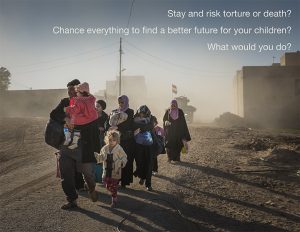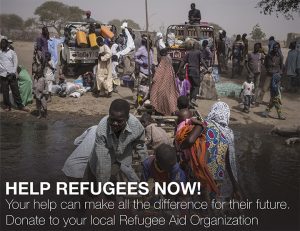Join us for conversations that inspire, recognize, and encourage innovation and best practices in the education profession.
Available on Apple Podcasts, Spotify, Google Podcasts, and more.
Displaced people are associated with many stereotypes, and these ideas permeate media culture. Photography, associated with evidentiary truth and the direct portrayal of the real world, has a special function in shaping attitudes. Studies have found that stereotypes, hate speech, and political rhetoric often influence journalists, and thus audiences are not provided with the full story or journalists overlook the story altogether.
In visual media, photographs and captions may function to support these ideas through various tropes and common formal techniques. Instead of a humanitarian situation, or a phenomenon that has broad and complex roots within political, economic, and social histories, the large numbers of poor displaced people are often labeled as a “crisis” and accompanying photographs can suggest an “invasion.” Displaced people are sensationally characterized as “swarms” or “flooding” into Europe and America. Audiences perceive these populations as threats to their economic livelihood and culture. Photographs vividly portray boats filled with people or long lines. Aerial photographs of large groups create the perception of untold numbers. Race is an important factor here: Displaced people are overwhelmingly non-white people. Media outlets may use a single photograph of a crowd to illustrate a news item, without recognizing the myriad life stories contained in that image. In other words, these media features tend to lump all displaced people together.
The subject of refugees is one topic that demonstrates the need for more critical media literacy and media habits. As media consumers access, analyze, evaluate, and create their own media content, they need to be aware of how we consume media, and the underlying stereotypes, biases, and political agendas that influence and shape stories about the refugee issue.
At the same time, visual evidence provided by satellite images made through geovisualization techniques can also be crucial to understanding the scale and impact of conflict and displacement. For example, human rights organizations used evidence from the integrative online site Eyes on Darfur in their advocacy work. Today, smartphones allow refugees to make their own images. Using sites such as Instagram, refugees can document their journeys and tell their stories themselves. In refugee camps, photography is also used as a creative outlet and as a therapeutic tool.
Photographs are often used in awareness campaigns as info-graphics to help the public learn about an important cause or situation. The impact of adding text and signage to a photograph helps project a very specific message. Have students view the photographs and consider how one could be used in an awareness campaign to help send a message about displacement, statelessness, or refugees.
In this activity, students will create posters and present them to classmates with an explanation about an event, and why a particular image and message was a good choice for shaping public opinion. Students may want to research a challenge facing refugees in the community or city where they live, or they could explore a challenge facing displaced persons in another city or community. Working in pairs or on their own, have students follow these five steps:
When developing your message, be aware of statistics. These could be used as text for your poster. Similarly, be aware of any quotations that inspire you, because you could add those words directly to your poster.
You can find more information about specific events during a particular year at www.un.org/en/events/refugeeday/. Students can also track this by using the hashtag: #WithRefugees

#10046
UNHCR/Ivor Prickett

#10048
UNHCR/Olivier Laban-Mattei
After reading, students can begin to think about novels, historical fiction, documentaries, and graphic novels as literary genres that can help inform the public about an important issue. Using Meet the Somalis as an example, have students design and write a photo essay about the life of a displaced person. Their imaginary photo essay should include eight images, each with a one or two sentence caption. Students should first identify a person as the subject for the essay. What age and what gender is this person? Where does this person live? What was their life like before their displacement? What caused their displacement? What was their journey like (if they are not internally displaced)? Do they live with family? What is their status? What are their challenges, worries, and hopes?